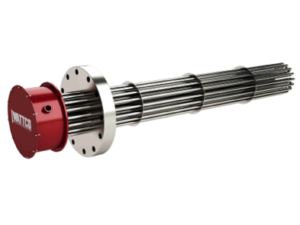Chemical Heating Using Flanged Heaters and Digital Temperature Controls
Last updated on September 26th, 2022 at 02:00 pm
Process heating is an integral part of the manufacture of many consumer and industrial products such as those made of metal, plastic, rubber, glass, concrete, and ceramics. Companies are always in the lookout for an industrial-level product or application that can provide precise level of heat for their industrial heating requirements. One of the more widely used heating devices is the flanged industrial immersion heater. This is often found in chemical, petroleum, and water heating elements. It uses direct heating to the liquid medium. Usually, a high limit sensor is utilized to prevent overheating of liquid mediums while offering protection to the flange heater as well. Designed for use in tanks and pressurized vessels, flanged immersion heaters are preferred in many applications because of its ease of installation and maintenance. It is available in different sizes, voltages, terminal enclosures and voltages. A typical flange immersion heater consists of a hairpin bent tubular that are welded into a flange. There are also additional wiring boxes in which electrical connections can be fixed. Some units are prefixed into flanges; others can be welded on matching flanges that have already been mounted on a nozzle or tank wall. 
Applications
Flanged immersion heaters can be used for the following applications:
- Preheating all grades of oil
- Food processing
- Cleaning and rinsing tanks
- Warming equipment
- Hot water storage
- Heat transfer systems
- Boiler equipment
- Freeze protection of any fluid
Advantages
Aside from being versatile as it can be used in a wide range of applications, flanged heaters are preferred in many industries because these are easy to install. Being movable not only makes installation easy, but also cleaning and replacement of an old unit convenient. Another advantage of flanged heater is that it is easy to use because its operation can be controlled digitally. This is particularly advantageous to companies where chemical heating requires a more defined procedure. Moreover, the heaters are almost independent because the energy input is provided by electric power and thus not necessitates any external process hookup. This makes flanged heaters energy efficient since all of the input electricity is directly converted to heat. In terms of costs, flanged heaters usually have a lower upfront price compare to its fossil-fuel counterparts. Long-term maintenance costs are also a lot lower. These attributes make these heating devices a relatively cheap and effective method for chemical heating across all industries.
Other Heating Devices
Aside from flanged heaters, inline heaters can also be used for chemical heating. A major advantage of inline circulation heaters for chemical heating is its ability to control temperature and regulate substance viscosity. This is achieved by pumping the fluid through a piping circuit surrounding the inline heater. The desired temperature is reached fast since the substance is constantly in contact with the heating element. Fluid viscosity is achieved because the fluid is in constant motion. Inline heaters also have precise temperature controls. Aside from that feature, most of the units today have standard features such as flow switch, safety thermostat and integral contractor. Inline heaters are also easy to install, much like flanged heaters. You can find immersion and inline heaters in Wattco’s wide portfolio of industrial heaters. Contact us for more information on chemical heating or get a quote on one of our flanged heaters today!
